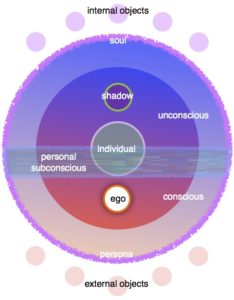“. . . beneath the neglected functions there lie hidden far higher individual values which . . . are of greatest value for individual life, and therefore vital values that can endow the life of the individual with an intensity and beauty he will vainly seek in his collective function.” — C.G. Jung
With this article, we begin a new series on the types in the inferior position. Seemingly lesser, for they are figuratively in the shadow, their role in individuation can be vital for discovering a rich and rewarding life. The content of this and forthcoming articles will be largely the product of a small group intensively studying the shadow types: Jungian analysts Gunilla Midbøe (SE), Barbara Helen Miller (NL), Vanessa Prins (NL), and myself. These articles will briefly summarize some of our findings. We expect to write a more complete article or book later to more substantially document our research.
The Shadow Types
While the differentiated types can be readily understood–we see them in people and experience them ourselves–the types in the inferior position are much more difficult to grasp. They linger beneath the surface and we must “dig deep” to uncover and observe them.
They may be ignored or demeaned, appearing to an individual as being less significant, for they usually directly oppose the conscious disposition; yet they are utterly vital to living a full and healthy life.
Jung noted that the inferior function is directly tied to the shadow and the soul (anima or animus). “I should only like to point out that the inferior function is practically identical with the dark side of the human personality.” (CW 9i, par. 222)
The shadow and soul are positioned as complementary opposites to the ego and persona. Jung depicted these relationships on a diagram in his 1925 seminars that illustrates the symmetrical and oppositional structure of the psyche.
1925 Diagram
 To better understand the oppositions, in the essays to follow, we will review the typological oppositions of shadow and soul under four roles:
To better understand the oppositions, in the essays to follow, we will review the typological oppositions of shadow and soul under four roles:
1. As Shadow Disposition
“The shadow is merely somewhat inferior, primitive, unadapted and awkward; not wholly bad. It even contains childish or primitive qualities which would in a way vitalize and embellish human existence.” (CW 11, par. 134)
How does each type manifest as a more primitive, childish type?
2. As Projection
How are the types projected under normal conditions, both as a shadow projection and as a soul projection?
3. As Healthy Oppositional Compensation
“There is no light without shadow and no psychic wholeness without imperfection. To round itself out life calls not for perfection but for completeness; and for this the “thorn in the flesh” is needed, the suffering of defects without which there is no progress and no ascent.” (CW 12, par. 208) How does each type appear as a “thorn in the flesh” of the conscious dispositions?
4. As Compensation for Extreme One-sidedness
“The unconscious has an inimical or ruthless bearing towards consciousness only when the latter adopts a false or pretentious attitude.” (CW 7, par. 346) How does that ruthless bearing occur, for each of the types?
These will be key roles and questions examined in upcoming articles, taking each type one at a time. In February’s article, we will start with the most relatable of the eight types–extraverted feeling–to see how extraverted feeling, as a shadow type, can be everything but relatable.
